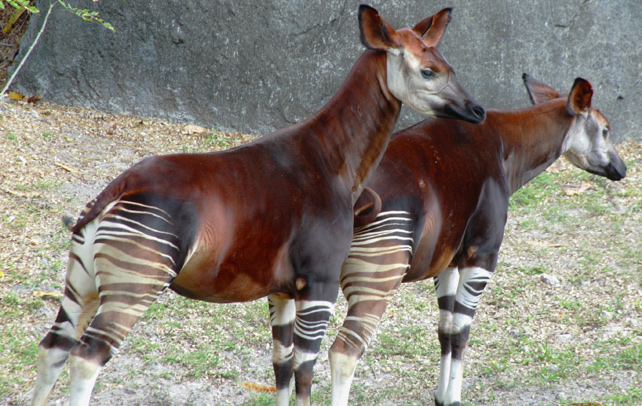Amazing Information About Okapis

Okapis, with their striped markings, may remind you of zebras, but in fact, they are the close cousins of giraffe, hailing from the giraffidae family. This giraffid artiodactyl mammal, found in the Ituri Rainforest in Congo, bears white stripes on its rear body and on the limbs, which interestingly makes it look like a zebra. Much of the morphological features of this wild herbivore resemble that of giraffe, apart from a notable difference that okapis have shorter neck than giraffe, though it is usually longer than other ruminants. The okapis have velvet-like smooth and soft, dark chestnut-brown or purplish red pelage that covers the body. They have a black muzzle, which is supported by the neck. They have large pinna and a long, black, prehensile tongue. Male okapis possess skin-covered horns on their head, which they develop during one to five years of age. The soft and gentle animals that inhabit the tropical rain forests are the only living relative of giraffe. Though gentle, they can be aggressive if provoked. Okapis have some interesting behaviors that help them to sustain in its competitive environment. Read on to know more interesting facts about okapi.
Fast Facts
Scientific Name: Okapia Johnstoni
Type: Mammal
Kingdom: Animalia
Phylum: Chordata
Class: Mammalia
Order: Artiodactyla
Family: Giraffidae
Genus: Okapia
Species: O. johnstoni
Origin: Africa
Diet: Herbivore
Size: 1.9 to 2.5m long and 1.5 to 2.0m tall
Weight: 200kg-300kg (440 to 660 lb)
Lifespan: 20 to 25 years
Habitat: Tropical rain forest
Sexual Maturity: Females at 2 years, males later
Gestation Period: 14-15 months
Number Of Offspring: 1 young one per litter
Amazing Infromation About Okapis
- Okapis are solitary animals and only come together for mating. However, mother-child dyads can be seen.
- Okapis have very long, flexible, dark-coloured tongues just like giraffe, which help them strip leaves and buds from trees. Okapis are one of those few animals in this planet that are said to be able to extend their tongue long out and lick their own ear!
- Okapis are herbivores and they feed primarily on leaves and buds, grass, ferns, fruit, and fungi. You might be surprised to know that a number of the plant species eaten by the okapi are poisonous to humans.
- Okapis feed on charcoal (from burnt trees) as well. They also take in sulfurous clay from the riverbanks to meet their mineral requirement.
- The okapis lead active life during the day, wandering over in search of food. They use fixed, well-trodden paths to ramble through the jungle.
- Okapis have a well-developed sense of smell, which helps them locate nearing predators and locate breeding partners.
- Males usually occupy larger areas than females. They mark these areas with urines and by rubbing their necks to trees.
- Male okapis use their neck to fight with other males, usually to settle territory disputes and compete for a female mate during the breeding season.
- Male okapis have horns that are fused with the frontal bone. These horns are covered with hairs and have an average of 15 cm length.
- Okapis have interdigital glands on the front and hind feet.
- The locomotary patterns of the okapis are much similar to giraffe, both of them simultaneously move the front and hind leg on the same side of the body. Other ungulates move by stepping alternate legs on either side of the body.
- Okapis are usually silent, but they make soft cough during the rut. Young animals have a wide repertoire of noises, including coughs, bleats, and whistles. Courtship patterns of the okapis include circling, sniffing, and licking each other. This is followed by the dominance of the mail okapi and eventually ends up in copulation.
- The okapi give birth to their young ones generally from August to October. The expectant mothers hide away in dense forest to deliver their young one and once the calf is born, they are hidden in a nest for several days. The calves receive infrequent nurse during this period and hence they do not defecate. This helps them to be safe from the predators.
- Okapis are precocial. They nurse young ones after 21 minutes after birth and the calves are able to stand after just 30 minutes. Strangely, the okapi calves do not seem to emboss much on their mother, they have seen to have nursing from two different females.
- Mother okapis are very protective of their young and they defend vigorously in case of any threat to their calves. The female beat on the ground with forelegs as a warning sign of fight.
- Weaning of the calves occur at about 6 months from the birth, although the calves may feed on breast milk for more than a year.
- Primary enemy of okapis are humans and the leopards.









